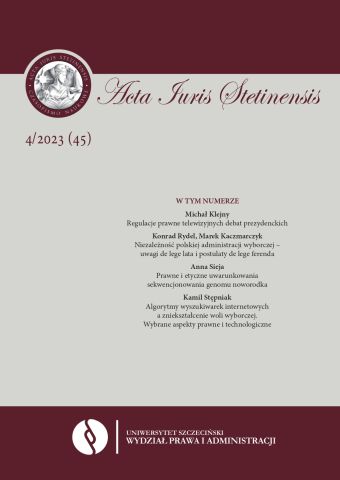






| Authors: |
Anna
Sieja

Uniwersytet Szczeciński |
| Keywords: | genome DNA Whole-Genome Sequencing (WGS) children’s rights bioethics of genetic research |
| Data publikacji całości: | 2023-12 |
| Page range: | 26 (75-100) |
| Downloads ?: | 97 |
| 1. | Anthony A., Volk J., Atkinson A., Infant and child death in the human environment of evolutionary adaptation, „Evolution and Human Behavior” 2013, vol. 34, www.sciencedirect.com/science/article/pii/S1090513812001237#s0015. |
| 2. | Bai N., Smith D., The Mysterious 98%: Scientists Look to Shine Light on Our Dark Genome, www.ucsf.edu/news/2017/02/405686/mysterious-98-scientists-look-shine-lightour-darkgenome#:~:text=But%20a%20perplexing%20problem%20quickly,do%20not%20code%20for%20proteins. |
| 3. | Berkman B.E., Hull S.C., The „right not to know” in the genomic era: time to break from tradition?, „American Journal of Bioethics” 2014, vol. 14 (3). |
| 4. | Biesecker L.G., Green E.D., Manolio T., Solomon B.D., Curtis D., Should all babies have their genome sequenced at birth?, „British Medical Journal” 2021 vol. 375. |
| 5. | Biuletyn Informacji Publicznej RPO, Adam Bodnar upomina się w resorcie zdrowia o ustawę dotyczącą testów genetycznych, https://bip.brpo.gov.pl/pl/content/adambodnar-za-ustawowym-uregulowaniem-testow-genetycznych. |
| 6. | Colby B., Whole Genome Sequencing Cost, https://sequencing.com/education-center/whole-genome-sequencing/whole-genome-sequencing-cost. |
| 7. | Devlin H., Scientists raise concerns over UK baby genome sequencing plan, www.theguardian.com/science/2021/dec/02/scientists-raise-concerns-over-uk-baby-genomesequencing-plan. |
| 8. | Dheensa S., Crawford G., Salter C., Parker M., Fenwick A., Lucassen A., How do clinical genetics consent forms address the familial approach to confidentiality and incidental findings? A mixed-methods study, „Familial Cancer” 2018, vol. 17 (1). |
| 9. | Friedman J.M., McGillivray B., Poradnictwo genetyczne, w: J. Friedmam (red.), Genetyka, pol. wyd. red. J. Limon, Wrocław 2002. |
| 10. | Gleim S., Surge in Ransomware Attacks Exposes U.S. Cyber Vulnerabilities, https://computer.howstuffworks.com/ransomware-attacks-news.htm. |
| 11. | Gudbjartsson D.F., Helgason H., Gudjonsson S. et al., Large-scale whole-genome sequencing of the Icelandic population, „Nature Genetics” 2015, vol. 47. |
| 12. | Haga S.B., Barry W.T., Mills R., Ginsburg G.S., Svetkey L., Sullivan J., Willard H.F., Public knowledge of and attitudes toward genetics and genetic testing, „Genetic Testing and Molecular Biomarkers” 2013, vol. 17 (4). |
| 13. | Hastings R., De Wert G., Fowler B. et al, The changing landscape of genetic testing and its impact on clinical and laboratory services and research in Europe, „European Journal of Human Genetics” 2012, vol. 20. |
| 14. | Hooper C., The genomic revolution is coming – and with it some big dilemmas, https://theconversation.com/the-genomic-revolution-is-coming-and-with-it-some-bigdilemmas-42101. |
| 15. | Kapelańska-Pręgowska J., Prawne i bioetyczne aspekty testów genetycznych, Warszawa 2011. |
| 16. | Kelly N., Makarem D.C., Wasserstein M.P., Screening of Newborns for Disorders with High Benefit-Risk Ratios Should Be Mandatory, „The Journal of Law, Medicine & Ethics” 2016, vol. 44 (2). |
| 17. | King D., Editing the human genome brings us one step closer to consumer eugenics, www.theguardian.com/commentisfree/2017/aug/04/editing-human-genome-consumereugenics-designer-babies. |
| 18. | Krajewska A., Wearing Genes to Work – do we care about genetic discrimination in employment?, „Anti-Discrimination Law Review” 2017, vol. 2. |
| 19. | Krekora-Zając D., Prawo do materiału genetycznego człowieka, Warszawa 2014. |
| 20. | Le Page M., At least 75 per cent of our DNA really is useless junk after all, www.newscientist.com/article/2140926-at-least-75-per-cent-of-our-dna-really-is-useless-junkafter-all. |
| 21. | Lewis T., 23 and Baby, „Nature” 2019, vol. 576, www.nature.com/articles/d41586-019-03715-w. |
| 22. | Levels & Trends in Child Mortality, Estimates developed by the UN Inter-agency Group for Child Mortality Estimation, Report 2021, https://childmortality.org/wp-content/uploads/2021/12/UNICEF-2021-Child-Mortality-Report.pdf. |
| 23. | Loudon I., Phillip Semmelweis’ studies of death in childbirth, „Journal of the Royal Society of Medicine” 2013, vol. 106 (11). |
| 24. | Malarewicz-Jakubów A., Dziecko jako pacjent, w: E.M. Guzik-Makaruk, V. Skrzypulec-Plinta, J. Szamatowicz (red.), Wybrane prawne i medyczne problemy ginekologii dziecięcej, Białystok 2015. |
| 25. | Maj F., Samopoczucie i samoaktualizacja osób zagrożonych onkologicznie, w: E. Kilar (red.), Genetyczne i onkologiczne problemy człowieka, Świdnica 2004. |
| 26. | Mayo Clinic Org, Huntington’s disease, www.mayoclinic.org/diseases-conditions/huntingtons-disease/symptoms-causes/syc-20356117. |
| 27. | McGuire A.L., Gabriel S., Tishkoff S.A. et al., The road ahead in genetics and genomics, „Nature Reviews Genetics” 2020, vol. 21. |
| 28. | McKie R., Human Genome Project, ‘The wondrous map’: how unlocking human DNA changed the course of science, www.theguardian.com/science/2020/jun/21/humangenome-project-unlocking-dna-covid-19-cystic-fibrosis-molecular-scientists. |
| 29. | Moody L., Atkinson L., Kehal I. et al., Healthcare professionals’ and parents’ experiences of the confirmatory testing period: a qualitative study of the UK expanded newborn screening pilot, „BMC Pediatrics” 2017, vol. 17. |
| 30. | Mullin E., The Price of DNA Sequencing Dropped From $2.7 Billion to $300 in Less Than 20 Years, https://onezero.medium.com/the-price-of-dna-sequencing-dropped-from-2-7-billion-to-300-in-less-than-20-years-f5e07c2f18b4. |
| 31. | Naqvi A.A.T., Fatima K., Mohammad T., Fatima U., Singh I.K., Singh A., Atif S.M., Hariprasad G., Hasan G.M., Hassan M.I., Insights into SARS-CoV-2 genome, structure, evolution, pathogenesis and therapies: Structural genomics approach. „BBA Molecular Basis of Disease” 2020, vol. 1866 (10). |
| 32. | Park J., Why do some places say the human genome is 6 billion bases, while others say 3 billion?, https://genetics.thetech.org/ask-a-geneticist/two-genomes-cell. |
| 33. | Radkowska-Walkowicz M., Reimann M., Dzieci i zdrowie. Wstęp do childhood studies, Warszawa 2020. |
| 34. | Remec Z.I., Podkrajsek K.T., Lampret B.R., Kovac J., Groselj U., Tesovnik, T., Battelino T., Debeljak M., Next-Generation Sequencing in Newborn Screening: A Review of Current State, „Frontiers in Genetics” 2021, vol. 12. |
| 35. | Roser M., Mortality in the past – around half died as children, https://ourworldindata.org/child-mortality-in-the-past. |
| 36. | Seidel M.G., Baby genome screening: paving the way to genetic discrimination?, „British Medical Journal” 2017, vol. 358. |
| 37. | Sharton B.R., Ransomware Attacks Are Spiking. Is Your Company Prepared?, https://hbr.org/2021/05/ransomware-attacks-are-spiking-is-your-company-prepared. |
| 38. | Sherburn I.A., Finlay K., Best S., How does the genomic naive public perceive whole genomic testing for health purposes? A scoping review, „European Journal of Human Genetics” 2023, vol. 31. |
| 39. | Singh S., The hundred-dollar genome: a health care cart before the genomic horse, „Canadian Medical Association Journal” 2018, vol. 190 (16). |
| 40. | Sun Y., Shang L., Zhu Q.H., Fan L., Guo L., Twenty years of plant genome sequencing: achievements and challenges, „Trends in Plant Science” 2022, vol. 27, nr 4. |
| 41. | Volk A.A., Atkinson J.A., Infant and child death in the human environment of evolutionary adaptation, „Evolution and Human Behavior” 2013, vol. 34, nr 3. |
| 42. | Zaske S., Big gaps in quest to sequence genomes of all animals, www.sciencedaily.com/releases/2021/12/211206090620.htm. |